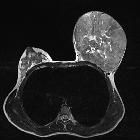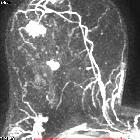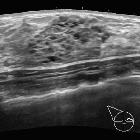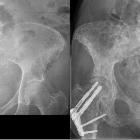breast cancer






























Breast neoplasms consist of a wide spectrum of pathologies from benign proliferations, high-risk lesions, precursor lesions, to invasive malignancies. This article provides an overview for radiologists, with a focus on breast cancer. For a summary article for medical students and non-radiologists, see breast cancer (summary).
Epidemiology
Breast cancer is the most common nonskin malignancy in women. In the affluent populations of North America, Europe, and Australia, 6% of women develop invasive breast cancer before age 75, compared to a 2% risk in developing regions of Africa and Asia . The difference has been attributed to risks associated with a Westernized lifestyle, including high-calorie diet rich in fat and protein and physical inactivity .
Risk factors
- increasing age
- reproductive lifestyle factors increasing unopposed estrogen load
- early menarche
- nulliparity, infertility, or, if parous, few children with late age at first delivery
- lack of breastfeeding
- late menopause
- unopposed estrogen hormone replacement therapy
- personal history of breast cancer or a high risk breast lesion
- first degree relative with breast cancer
- genetic mutations
- thoracic radiation therapy
- alcohol consumption
Pathology
Classification
The main pathological classification of breast neoplasms is published by the World Health Organization: WHO classification of tumors of the breast.
The vast majority of breast cancers are adenocarcinomas (99%). The most common types are :
- invasive carcinoma of no special type (ductal carcinoma not otherwise specified): 40-75%
- ductal carcinoma in situ: 20-25%
- invasive lobular carcinoma: 5-15%
Categories of benign epithelial neoplasms include:
Nonepithelial malignancies are uncommon and include:
Immunophenotype
Three molecular biomarkers are routinely evaluated in invasive breast cancers because they have therapeutic implications:
- estrogen receptor (ER)
- progesterone receptor (PR)
- human epidermal growth factor receptor 2 (HER2; protooncogene Neu; receptor tyrosine-protein kinase erbB-2)
Staging
Staging of breast tumors is performed according to the TNM system published by the American Joint Committee on Cancer (AJCC)/Union for International Cancer Control (UICC): breast cancer (staging).
Radiographic appearance
Dedicated evaluation of the breast involves multiple imaging modalities to detect and localize lesions for biopsy. In all modalities, regional metastasis can be suspected by the presence of axillary adenopathy.
Mammography
Neoplasms have varied appearances, including masses, asymmetries, calcifications, or architectural distortions.
Ultrasound
Neoplasms can appear as masses or architectural distortions. Calcifications can sometimes be seen.
MRI
Neoplasms can manifest as masses with or without enhancement, nonmass enhancement, or foci of enhancement.
CT
Breast masses may be incidentally identified but CT is not the preferred modality for dedicated breast evaluation. If calcifications are visualized on CT, they are nearly all benign .
Radiology report
The use of a standard lexicon is recommended to enhance communication with referrers and audit performance: breast imaging-reporting and data system (BI-RADS).
Siehe auch:
- invasives lobuläres Karzinom
- breast lumps
- intraductales Papillom der Mamma
- Morbus Paget der Mamille
- Metastasen bei Mammakarzinom
- Phylloidestumor
- duktales in situ Karzinom der Mamma
- Mammakarzinom beim Mann
- Fibromatose der Mamma
- Lymphom der Mamma
- tubular carcinoma of breast
- lobular carcinoma in situ (LCIS)
- Granularzelltumor der Mamma
- adenoid cystic carcinoma of the breast
- Sarkom der Mamma
- Mamma MRT Kontrastmitteldynamik
- artifacts that mimic breast calcification
- inflammatorisches Mammakarzinom
- Liposarkom der Mamma
- komplizierte Zyste Mamma
- Malignitätskriterien Sonographie Mamma
- apocrine carcinoma of the breast
- extraskelettales Osteosarkom der Mamma
- Kontrastmittel in der Magnetresonanztomographie
- Angiosarkom der Mamma
- papilläre Neoplasien der Mamma
- Mamma-MRT
- medullary breast carcinoma
- papilläres Mammakarzinom
- tubulolobular carcinoma of breast
- metastasis to the breast
- metaplastic carcinoma of the breast
- Atypische duktale Hyperplasie (ADH)
- Mammakarzinom Sonographie
- invasives muzinöses Mammakarzinom
- Juvenile Papillomatose der Mamma
- atypische lobuläre Hyperplasie (ALH)
- Nicht-Komedo duktales in situ Karzinom der Mamma
- maligner Phylloidestumor
- Mammakarzinom Staging
- comedo type
- Fibrosarkom der Mamma
- breast screening
- terminal duct lobular unit (TDLU)
- metastasis(es) to breast
und weiter:
- Tumoren der Schädelkalotte
- osteoblastische Knochenmetastasen
- Kerley-Linien
- Superscan Szintigraphie
- solitäre lytische Läsion des Schädels
- breast curriculum
- tree in bud-Muster
- cancer
- Metastasen in der Orbita
- Krukenberg-Tumor
- miliare Lungenherde
- ultrasound appearances of liver metastases
- verkalkte Metastasen
- bilaterale axilläre Lymphadenopathie
- Cowden-Syndrom
- breast ultrasound
- hyperdenser Lymphknoten
- FIGO-Klassifikation
- chronische abakterielle Mastitis
- Galaktozele
- fibroadenomatoid mastopathy
- tubular carcinoma of the breast
- miliary nodules in the exam
- diabetische Mastopathie
- ivory vertebra sign
- differential diagnosis of unilateral axillary lymphadenopathy
- hyperechoic breast lesions
- metastatic axillary lymphadenopathy of unknown primary
- seltene Mammatumoren
- Somatostatin-Rezeptor-Szintigrafie
- einfache Zyste Mamma
- LCIS
- microglandular adenosis of the breast
- architectural distortion in mammography
- breast screening programmes
- triple receptor negative breast cancer
- medullary carcinoma of the breast
- Brachytherapie
- gemischt osteolytisch osteoblastische Knochenmetastasen
- postoperative Narben Mamma
- Mammakarzinom in einer Zyste
- idiopathische granulomatöse Mastitis
- differential diagnosis of calcific axillary lymphadenopathy
- Brustdichte in der Mammographie
- ductal adenoma of breast
- sklerosierende Adenose der Mamma
- lobular breast carcinoma
- pregnancy associated breast cancer
- Abszess der Mamma
- granulomatöse Mastitiden allgemein
- multi-focal breast cancer
- intracystic papillary carcinoma of the breast
- differential diagnosis of dilated mammary veins
- differential diagnosis of dilated ducts on breast imaging
- bilateral lobular carcinoma of the breast
- eingeblutete Metastasen
- multi-centric breast cancer
- radiäre Narbe der Mamma
- breast self-examination
- Senologie
- hyperdense pulmonale Raumforderungen
- Lungenmetastasen bei Mammakarzinom
- Metastasen in der Cervix uteri
- scirrhous carcinoma of the breast
- asymmetrische mammographische Dichte
- Morbus Mondor
- Metastasen in der Hypophyse

 Assoziationen und Differentialdiagnosen zu Neoplasien der Mamma:
Assoziationen und Differentialdiagnosen zu Neoplasien der Mamma:





















